Key takeaways:
- Strong patient-provider relationships enhance treatment adherence and improve patient outcomes through trust and open communication.
- Effective communication, including the use of open-ended questions and non-verbal cues, fosters emotional connections and encourages patient engagement.
- Personalizing interactions by remembering details about patients and tailoring communication styles builds trust and makes patients feel valued.
- Gathering and acting on patient feedback is essential for continuous improvement in care quality and strengthens the patient-provider bond.

Understanding patient relationships importance
Building strong relationships with patients is fundamental to effective healthcare. I remember a patient I encountered who was anxious about a diagnosis. Taking the time to communicate openly allowed her to express her fears, and in turn, this trust led to better compliance with her treatment plan. It’s moments like these that highlight how a strong relationship can significantly impact patient outcomes.
Consider the role of empathy in this dynamic. When I genuinely listen to a patient’s concerns, I often see relief wash over them. This emotional connection creates a safe space where patients feel valued and understood. Don’t you think that feeling listened to can make all the difference in a patient’s experience?
Moreover, building these relationships fosters a partnership in health. I’ve seen how collaborative interactions empower patients to take charge of their well-being. This two-way relationship, rooted in trust and communication, not only enhances treatment adherence but also encourages patients to share crucial information that could affect their health decisions.
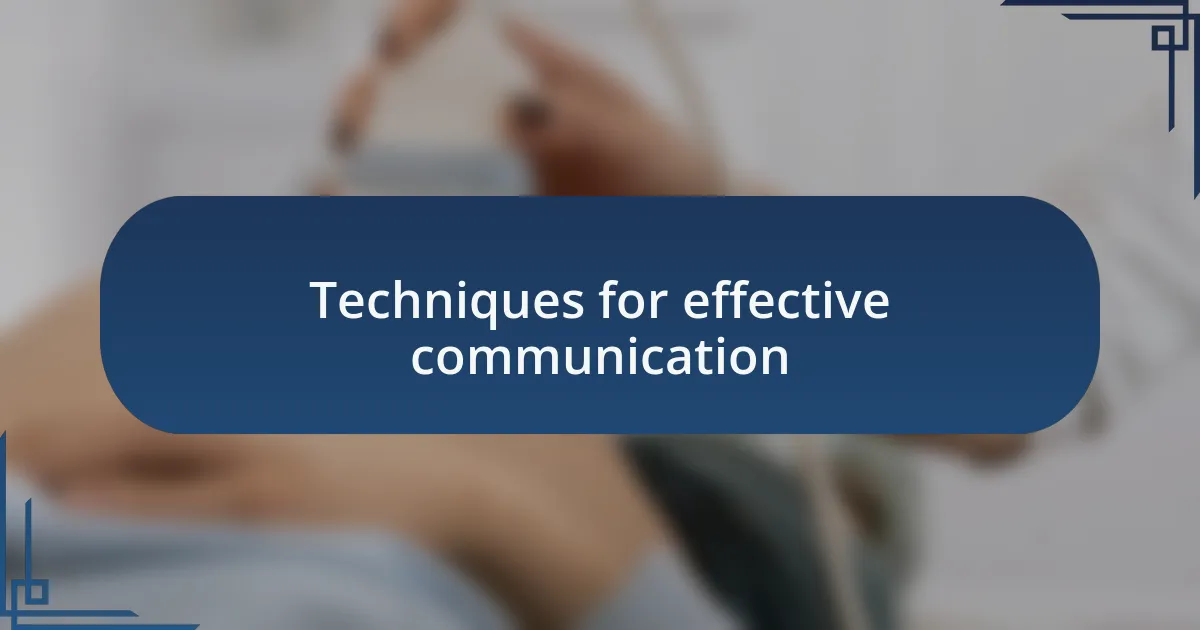
Techniques for effective communication
Effective communication is a skill that I’ve honed over years of interacting with patients. One technique that stands out is the use of open-ended questions. I remember asking a patient about her lifestyle during a routine check-up, and her response opened a fascinating dialogue about her daily challenges. This approach not only provided valuable insight into her health but also helped her feel encouraged to discuss her needs more freely.
Non-verbal cues are equally essential in my practice. I’ve often noticed how a reassuring smile or a gentle nod can put a patient at ease. For instance, during a particularly sensitive conversation about treatment options, I made it a point to maintain eye contact and mirror her body language. Did it make a difference? Absolutely. It signaled that I was present and fully engaged, which helped cultivate trust and openness.
Moreover, I’ve learned that providing clear and concise information can alleviate anxiety for many patients. Recently, after explaining a complex medical term using simple language and analogies, I saw the confusion lift from a patient’s face. It was a reminder that clarity not only empowers patients but fosters a collaborative dialogue. How do we ensure our patients truly understand? By taking the time to explain things in a relatable manner, we can bridge that gap and enhance their overall experience.
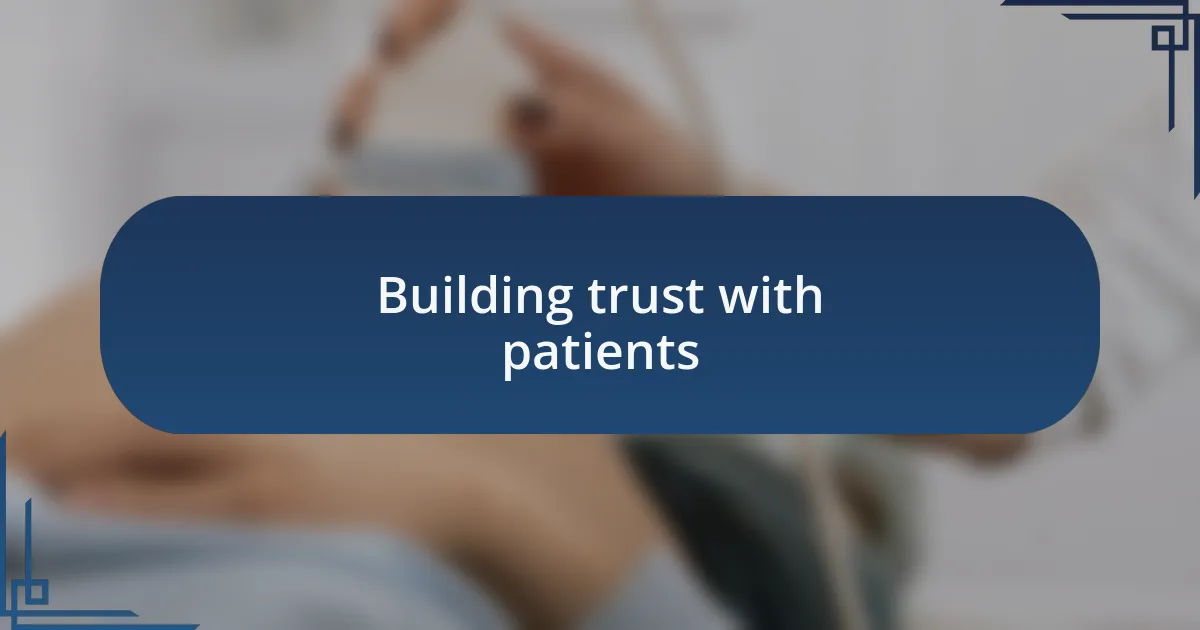
Building trust with patients
Building trust with patients hinges on authenticity. I recall a moment with a patient who felt uneasy about their diagnosis. Instead of presenting a facade of confidence, I chose to share my own vulnerable experiences with uncertainty in medicine. This openness not only deepened our connection but also allowed them to feel safe expressing their fears. Isn’t it fascinating how sharing our humanity can create such powerful bonds?
Consistency plays a vital role in establishing trust as well. I make it a point to follow up with patients, checking in on their progress and reminding them that their care goes beyond just office visits. One patient even told me that receiving a call from me after a treatment made her feel valued and respected. Isn’t it incredible how simple gestures can reinforce the trust we build during our encounters?
Finally, actively listening is crucial. There was a time when a patient shared her struggles with managing her medication. Instead of just hearing her words, I focused on understanding her feelings and the context around them. This not only led to a more tailored treatment plan but also confirmed her trust in our partnership. How often do we truly listen, rather than just waiting for our turn to speak? It’s this level of attentiveness that solidifies our relationships with patients, paving the way for a healthier journey together.
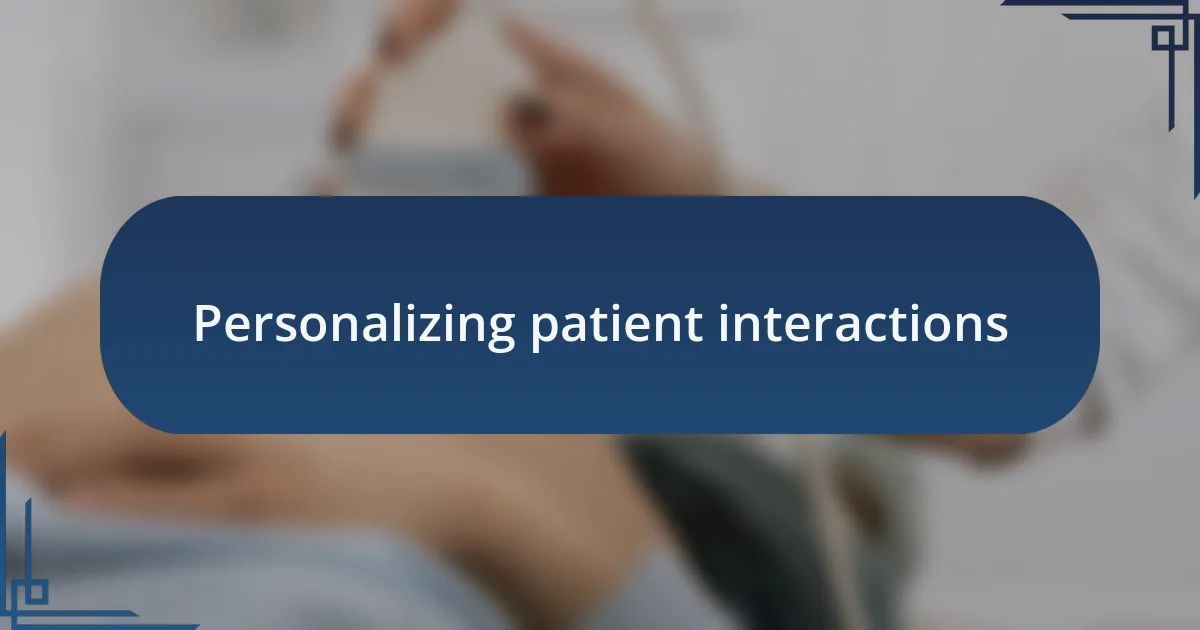
Personalizing patient interactions
When it comes to personalizing patient interactions, I find that remembering personal details is crucial. I once treated a patient who mentioned her love for gardening during our first meeting. The next time we spoke, I asked about the flowers she was planting, and her face lit up with enthusiasm. It’s amazing how such a small conversation starter can shift the dynamics, making patients feel more seen and appreciated.
Moreover, I believe that body language plays a significant role in how we communicate. There was an instance where a patient seemed anxious during a consultation. By leaning slightly forward and maintaining eye contact, I reassured her without saying a word. This non-verbal cue signaled my genuine interest in her wellbeing and made her feel more at ease. Have you ever noticed how a simple gesture can foster a deeper connection?
Additionally, I’ve learned that tailoring my communication style to each patient’s preferences is essential. For example, I had a patient who preferred concise information over in-depth explanations. By adjusting my approach, I respected her preferences and ensured she understood her treatment plan. It made me reflect: how often do we forget that every individual has unique needs and desires? Personalizing interactions is not just about patients feeling comfortable; it’s about engaging them in a way that resonates personally with them.
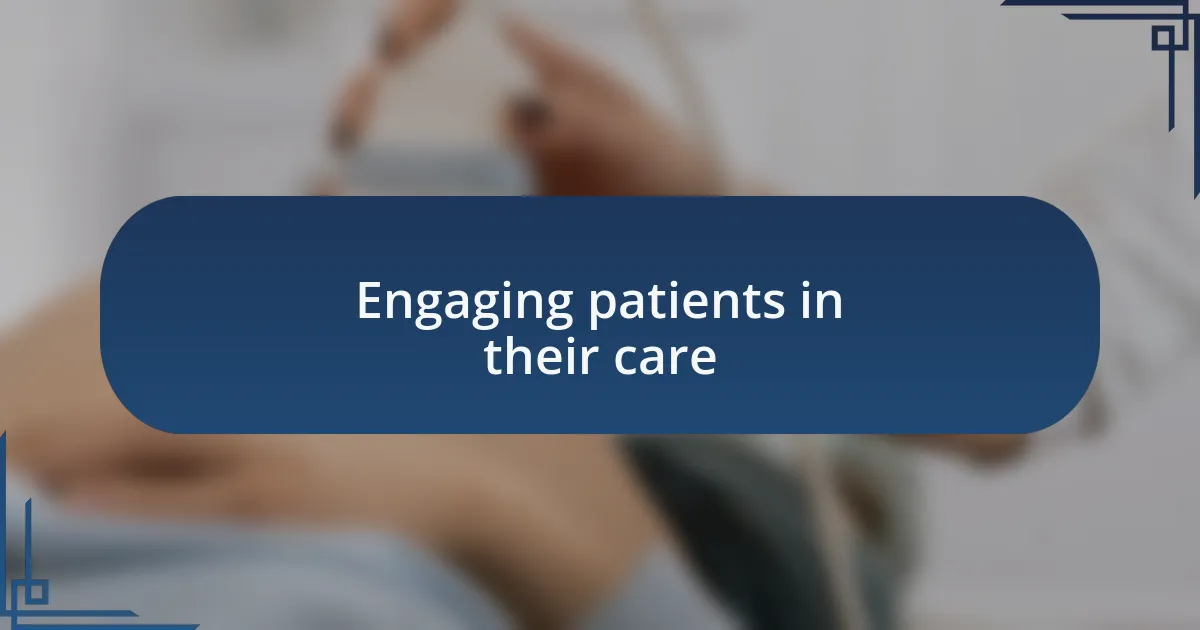
Engaging patients in their care
Engaging patients in their care requires a collaborative approach that empowers them in the decision-making process. In my experience, I’ve often asked patients open-ended questions about their thoughts on treatment options. I can recall a moment when a patient voiced concerns about a prescribed medication. Instead of simply reassuring her, I invited her to share her feelings, which led to a thoughtful discussion. By facilitating that dialogue, she felt more invested and understood, transforming the appointment from a monologue into a partnership.
I’ve also found that providing educational resources can significantly boost engagement. During one consultation, a patient struggled to comprehend the implications of his diagnosis. I took the time to share easy-to-understand materials and even sketched out diagrams to illustrate key points. The look of realization on his face was rewarding; he had become an active participant in his care, asking questions and expressing opinions. How often do we consider that information, when presented clearly, can empower patients to take charge of their health?
Lastly, follow-up communication plays a pivotal role in maintaining engagement. After completing a treatment, I like to check in with my patients via phone or email. For instance, I once contacted a patient to see how she was feeling post-surgery, which opened up a conversation about her recovery journey. This simple act informed her that I genuinely cared, reinforcing her role in her care process. Engaging patients this way builds trust and encourages them to share concerns openly, ultimately leading to better health outcomes.
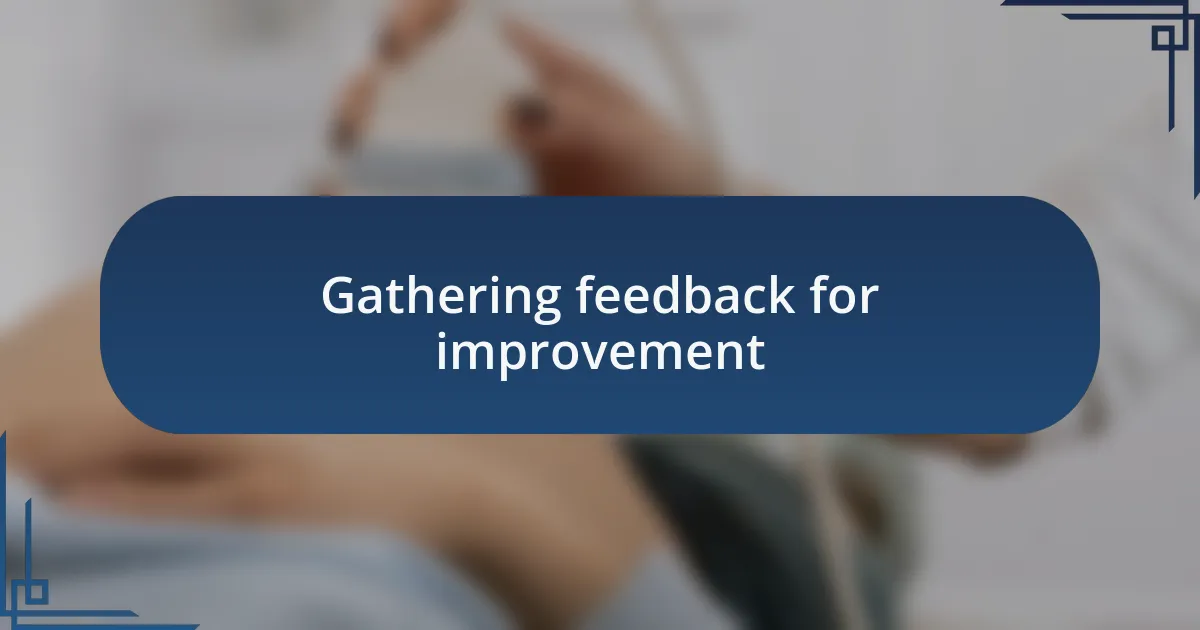
Gathering feedback for improvement
Gathering feedback is an essential tool for continuous improvement in patient care. One time, I introduced a brief anonymous survey after appointments to gauge patient satisfaction. To my surprise, the feedback revealed valuable insights about some processes I thought were effective but, in reality, left patients feeling confused. This experience taught me that what seems clear to me might not resonate with patients, highlighting the need for their honest perspectives.
I’ve also started incorporating real-time feedback during consultations. On one occasion, while discussing treatment options, I asked a patient if the information I provided was helpful. She hesitated, then pointed out that I was using too much medical jargon. This moment was enlightening—by simply asking for her input, I was able to adjust my communication style, making it more relatable and easier for her to understand. It reinforced my belief that patients appreciate being part of the conversation.
Each piece of feedback is a stepping stone toward enhancing patient relationships. I remember implementing changes based on patients’ suggestions about waiting times, which led to noticeably shorter and more organized visits. When patients see that their opinions matter and lead to tangible changes, it strengthens our bond. How often do we truly listen to those we serve and act on their input? Turning their feedback into actionable improvements not only fosters trust but also ensures that the care we provide is as patient-centered as possible.
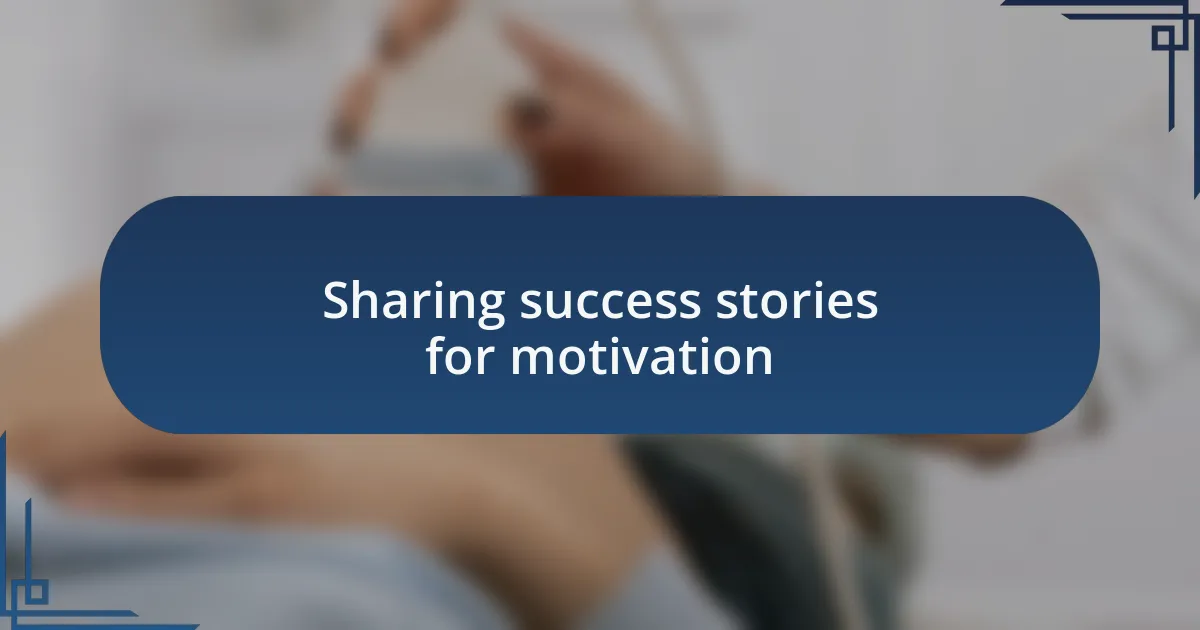
Sharing success stories for motivation
Sharing success stories can truly serve as a beacon of motivation for both patients and healthcare providers. I once had a patient who, after struggling with weight management for years, achieved significant progress through dedication and a strong support system. When she came back to share her story, it was not just about the numbers on the scale; it was the joy in her voice and the sparkle in her eyes that resonated with everyone in the clinic. How powerful is it to see firsthand the impact that personalized care and encouragement can have on someone’s journey?
In another instance, I created a small bulletin board in my office where patients could post their successes, big or small. From overcoming a significant health challenge to simply sticking to a new exercise routine, these stories breathed life into our practice. One day, a timid patient approached me, saying she felt inspired to take control of her health after reading about someone like her who had overcome similar hurdles. In sharing our successes, we empower others to believe that change is possible. Isn’t it uplifting to know that a simple story can spark hope in someone’s heart?
Moreover, I find that stories of triumph not only energize my patients but also motivate me as a provider. It reminds me of why I entered healthcare in the first place—to make a difference, one individual at a time. I often reflect on how each small success contributes to a larger narrative about resilience and perseverance. In a world where challenges are plentiful, isn’t it vital we celebrate the victories? Meeting patients where they are, through shared experiences, creates a community built on trust and inspiration.